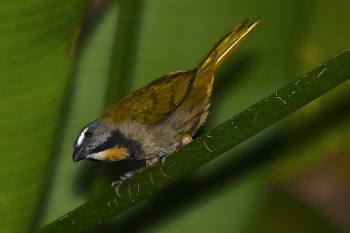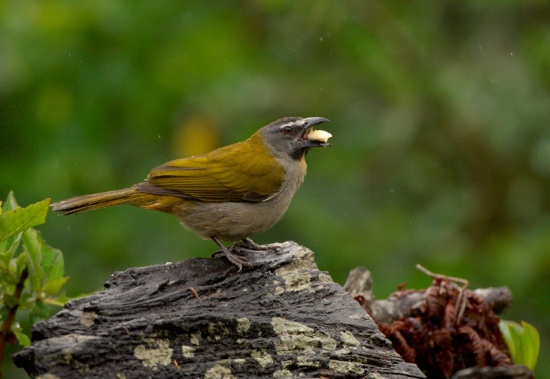- Saltator maximus
Identification
20·5–21 cm (8 in)
- Olive green above
- Grey below
- Buff lower belly
- Buff throat edged black
- Grey head
- White supercilium
- Green crown
- Black thick bill
- Black legs

Photo © by Stanley Jones
Bosque del Río Tigre Lodge, Osa Peninsula, Puntarenas Province, Costa Rica, February 2015
Juvenile: duller
- White-mottled blackish throat and breast
- Brown marked below
Distribution
Central and South America
Central America: Mexico, Guatemala, Belize, El Salvador, Honduras, Nicaragua, Costa Rica and Panama
South America: Colombia, Venezuela, Guyana, Suriname, French Guiana, Ecuador, Peru, Bolivia and Brazil
Taxonomy
Subspecies
There are 5 subspecies[1]:
- S. m. gigantodes:
- S. m. magnoides:
- S. m. intermedius:
- South-western Costa Rica to western Panama (Canal Zone)
- S. m. iungens:
- S. m. maximus:
Habitat
Dense vegetation in lowland humid forest and forest edges. Also visits bushy suburban gardens. Observed at heights of 1150m.
Behaviour
Diet
The feed at low and mid levels, sometimes with mixed species flocks. The diet includes fruit, berries, nectar, buds and insects.
Will eat bananas at bird tables.
Breeding
It builds a bulky cup nest. The clutch consists of 2 pale blue eggs.
References
- Clements, J. F., T. S. Schulenberg, M. J. Iliff, D. Roberson, T. A. Fredericks, B. L. Sullivan, and C. L. Wood. 2014. The eBird/Clements checklist of birds of the world: Version 6.9., with updates to August 2014. Downloaded from http://www.birds.cornell.edu/clementschecklist/download/
- Avibase
- Wikipedia
- BF Member observations
- Handbook of the Birds of the World Alive (retrieved June 2015)
Recommended Citation
- BirdForum Opus contributors. (2025) Buff-throated Saltator. In: BirdForum, the forum for wild birds and birding. Retrieved 20 April 2025 from https://www.birdforum.net/opus/Buff-throated_Saltator
External Links
GSearch checked for 2020 platform.1




